Quick Summary:
- Plan your site by defining audience and goals.
- Design user-friendly with compelling visuals and content.
- Optimize for mobile, SEO, and conversions using data.
- Maintain security, update content, and adapt to trends.
Table of Contents
- Understanding the Foundation: What is a Digital Branding Website and Why Do You Need One?
- What is a Digital Branding Website? Defining Your Online Identity
- Why is a Digital Branding Website Essential for Success? Beyond the Basics
- Planning Your Digital Branding Website: Strategy is Key
- Defining Your Target Audience: Who Are You Trying to Reach?
- Defining Your Brand Voice and Messaging: Telling Your Story
- Setting Clear Goals and Objectives: What Do You Want to Achieve?
- Keyword Research and SEO Planning: Getting Found Online
- Creative Design and Development: Bringing Your Brand to Life
- Choosing the Right Platform: CMS Selection and Considerations
- Designing a User-Friendly Website: UX/UI Best Practices
- Creating Compelling Visuals: Photography, Videography, and Graphic Design
- Content Creation: Crafting Engaging and Informative Content
- Optimizing Your Digital Branding Website: Performance and Growth
- Mobile Optimization: Reaching the Mobile Audience
- Search Engine Optimization (SEO): Driving Organic Traffic
- Website Analytics: Tracking and Measuring Results
- Conversion Rate Optimization (CRO): Turning Visitors into Customers
- Maintaining and Evolving Your Digital Branding Website: Long-Term Success
- Regular Content Updates: Keeping Your Website Fresh
- Security and Maintenance: Protecting Your Investment
- Adapting to Changing Trends: Staying Ahead of the Curve
- Qrolic Technologies: Your Partner in Digital Branding Success
- Conclusion: Your Journey to a Powerful Digital Brand
Understanding the Foundation: What is a Digital Branding Website and Why Do You Need One?
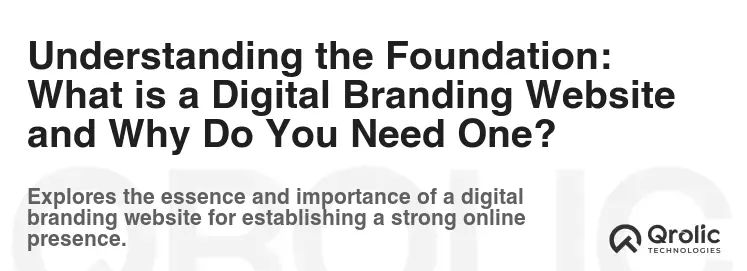
What is a Digital Branding Website? Defining Your Online Identity
A digital branding website is more than just an online brochure. It’s the digital embodiment of your brand, a curated online experience that communicates your values, personality, and purpose to the world. Think of it as your 24/7 brand ambassador, working tirelessly to build connections, generate leads, and drive sales. It’s the central hub of your online presence, directing visitors from social media, email marketing, and other channels.
Unlike a simple website, a digital branding website is strategically designed to:
- Establish a strong brand identity: Visual elements, tone of voice, and content all work together to communicate your unique brand personality.
- Build trust and credibility: Showcasing expertise, testimonials, and transparent business practices fosters trust with potential customers.
- Connect with your target audience: Tailoring your content and design to resonate with your ideal customer creates a strong connection.
- Drive conversions: Guiding visitors through a clear customer journey, from initial awareness to purchase, maximizes conversion rates.
Why is a Digital Branding Website Essential for Success? Beyond the Basics
In today’s digital landscape, a strong online presence is no longer optional; it’s essential for survival. A well-crafted digital branding website offers numerous benefits:
- Increased Brand Visibility: It helps you get discovered by more people searching for products or services like yours, boosting your overall visibility.
- Enhanced Brand Authority: A professional and informative website positions you as an expert in your field, building authority and credibility.
- Improved Customer Experience: Provides a seamless and engaging experience that fosters loyalty and encourages repeat business.
- Better Lead Generation: Captures leads through forms, calls-to-action, and valuable content offerings.
- Higher Conversion Rates: Turns website visitors into paying customers through persuasive content and strategic design.
- Measurable Results: Provides data and insights to track your progress and make informed decisions about your digital branding strategy.
- Competitive Advantage: Differentiates you from competitors and helps you stand out in a crowded marketplace.
Think of Apple’s website. It’s not just about selling products; it’s about conveying the brand’s values of innovation, simplicity, and design excellence. Every element, from the imagery to the copy, reinforces the Apple brand.
Planning Your Digital Branding Website: Strategy is Key
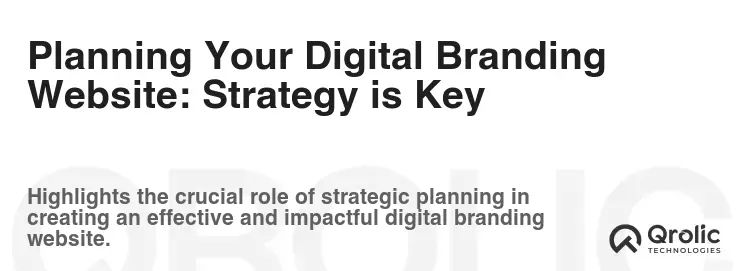
Defining Your Target Audience: Who Are You Trying to Reach?
Before you start designing your website, you need to understand your target audience inside and out. This means creating detailed buyer personas that outline their demographics, psychographics, pain points, and goals.
Ask yourself:
- Who are they? (Age, gender, location, income, education)
- What are their interests? (Hobbies, passions, values)
- What are their pain points? (Challenges they face, problems they need solved)
- What are their goals? (What do they want to achieve?)
- How do they use the internet? (What websites do they visit, what social media platforms do they use?)
By understanding your target audience, you can tailor your website content and design to resonate with them, creating a more engaging and effective experience.
Defining Your Brand Voice and Messaging: Telling Your Story
Your brand voice is the personality and tone of your brand, while your messaging is the specific content you use to communicate your value proposition. Both are crucial for creating a consistent and compelling brand identity.
Consider these questions:
- What are your core values? (Honesty, integrity, innovation, customer service)
- What is your brand personality? (Friendly, professional, playful, authoritative)
- What is your unique selling proposition (USP)? (What makes you different from your competitors?)
- What are the key messages you want to communicate? (Benefits of your products/services, value you provide)
Use a brand style guide to document your brand voice and messaging, ensuring consistency across all your online and offline channels.
Setting Clear Goals and Objectives: What Do You Want to Achieve?
What do you want your digital branding website to accomplish? Do you want to generate leads, drive sales, build brand awareness, or provide customer support? Setting clear goals and objectives will help you measure the success of your website and make informed decisions about your digital branding strategy.
Examples of goals include:
- Increase Website Traffic by 20% in the next quarter.
- Generate 100 leads per month through the website.
- Increase online sales by 15% in the next year.
- Improve customer satisfaction scores by 10%.
Make sure your goals are SMART: Specific, Measurable, Achievable, Relevant, and Time-bound.
Keyword Research and SEO Planning: Getting Found Online
Keyword research is the process of identifying the terms and phrases that your target audience uses to search for products or services like yours. Incorporating these keywords into your website content will help you rank higher in search engine results and attract more organic traffic.
Use tools like Google Keyword Planner, SEMrush, or Ahrefs to:
- Identify relevant keywords: Brainstorm a list of potential keywords and use these tools to find related terms with high search volume and low competition.
- Analyze your competitors: See what keywords your competitors are ranking for and identify opportunities to outrank them.
- Create a keyword strategy: Develop a plan for incorporating keywords into your website content, including page titles, meta descriptions, headings, and body text.
Remember to focus on long-tail keywords (longer, more specific phrases) as they often have less competition and can attract highly qualified traffic. For example, instead of “shoes,” target “best running shoes for women with flat feet.”
Creative Design and Development: Bringing Your Brand to Life
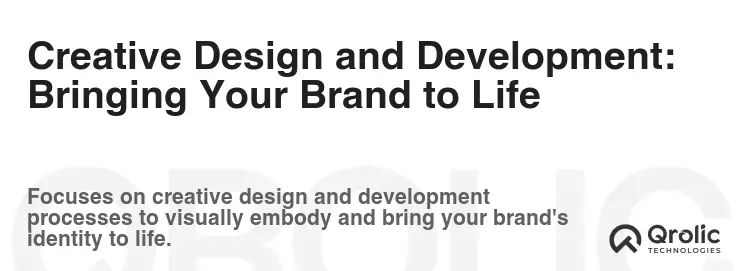
Choosing the Right Platform: CMS Selection and Considerations
Selecting the right content management system (CMS) is crucial for creating a website that is easy to manage, scalable, and optimized for search engines. Some popular CMS platforms include:
- wordpress: The most popular CMS in the world, known for its flexibility, extensive plugin library, and SEO-friendly features.
- Shopify: A leading e-commerce platform that simplifies the process of creating and managing an online store.
- Squarespace: A user-friendly platform that offers beautiful templates and drag-and-drop functionality, ideal for small businesses and creatives.
- Wix: Another popular drag-and-drop website builder, known for its ease of use and affordable pricing plans.
Consider your technical skills, budget, and specific needs when choosing a CMS. WordPress is a great option for those who want more control and flexibility, while Shopify is ideal for e-commerce businesses. Squarespace and Wix are good choices for beginners who want a simple and affordable solution.
Designing a User-Friendly Website: UX/UI Best Practices
User experience (UX) and user interface (UI) are critical for creating a website that is engaging, intuitive, and easy to navigate. A good UX/UI design will keep visitors on your website longer, reduce bounce rates, and increase conversion rates.
Key UX/UI best practices include:
- Clear Navigation: Make it easy for visitors to find what they’re looking for with a well-organized menu and clear calls-to-action.
- Mobile Responsiveness: Ensure your website looks and functions flawlessly on all devices, including smartphones and tablets.
- Fast Loading Speed: Optimize your website for speed to reduce bounce rates and improve user experience. Use tools like Google PageSpeed Insights to identify areas for improvement.
- Accessibility: Design your website to be accessible to people with disabilities, following WCAG guidelines.
- Visual Hierarchy: Use visual cues like font size, color, and spacing to guide visitors’ eyes and highlight important information.
- Consistent Branding: Maintain a consistent visual style throughout your website to reinforce your brand identity.
- Minimize Clutter: Keep your website clean and uncluttered to avoid overwhelming visitors.
Creating Compelling Visuals: Photography, Videography, and Graphic Design
Visuals play a crucial role in attracting and engaging visitors. High-quality photography, videography, and graphic design can help you communicate your brand story and create a memorable online experience.
- Photography: Use professional photos that showcase your products, services, and team. Avoid using stock photos that look generic and unauthentic.
- Videography: Incorporate videos to tell your brand story, demonstrate your products, or provide tutorials. Videos can significantly increase engagement and conversion rates.
- Graphic Design: Use graphic design elements like logos, icons, and illustrations to enhance your website’s visual appeal and reinforce your brand identity.
Ensure your visuals are consistent with your brand style guide and optimized for the web to minimize loading times.
Content Creation: Crafting Engaging and Informative Content
Content is king! High-quality, informative, and engaging content is essential for attracting visitors, building trust, and driving conversions.
Focus on creating content that is:
- Relevant: Addresses the needs and interests of your target audience.
- Valuable: Provides helpful information, insights, or solutions.
- Engaging: Captures attention and keeps visitors on your website longer.
- SEO-Friendly: Incorporates relevant keywords to improve search engine rankings.
Examples of content types include:
- Blog posts: Share your expertise, provide valuable information, and drive organic traffic.
- Case studies: Showcase your success stories and build credibility.
- White papers: Offer in-depth analysis and thought leadership.
- Ebooks: Provide comprehensive guides on specific topics.
- Infographics: Present data and information in a visually appealing format.
- Product descriptions: Highlight the benefits of your products and encourage purchases.
- About Us page: Tell your brand story and connect with your audience on a personal level.
Optimizing Your Digital Branding Website: Performance and Growth
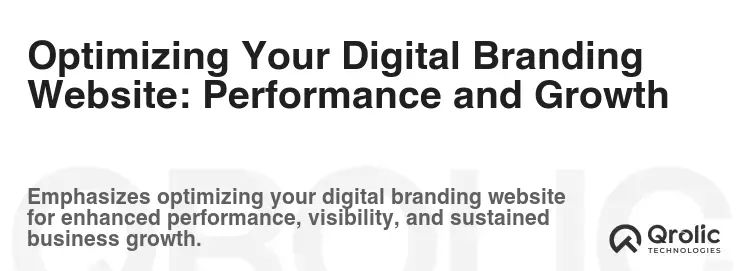
Mobile Optimization: Reaching the Mobile Audience
With the majority of internet users accessing websites on mobile devices, mobile optimization is no longer optional; it’s a necessity. Ensure your website is fully responsive and provides a seamless experience on all screen sizes.
Key mobile optimization strategies include:
- Responsive Design: Use a responsive design framework that automatically adjusts your website layout to fit different screen sizes.
- Fast Loading Speed: Optimize your website for speed to minimize loading times on mobile devices.
- Touch-Friendly Navigation: Make it easy for users to navigate your website using touch gestures.
- Simplified Forms: Simplify your forms to make them easier to fill out on mobile devices.
- Large Font Sizes: Use large font sizes to make your content easily readable on small screens.
- Optimize Images: Reduce the file size of your images without sacrificing quality to improve loading speeds.
- Use Mobile-Specific Features: Leverage mobile-specific features like click-to-call buttons and location-based services to enhance the user experience.
Search Engine Optimization (SEO): Driving Organic Traffic
SEO is the process of optimizing your website to rank higher in search engine results, driving organic traffic to your website.
Key SEO strategies include:
- Keyword Research: Identify relevant keywords and incorporate them into your website content.
- On-Page Optimization: Optimize your page titles, meta descriptions, headings, and body text with relevant keywords.
- Off-Page Optimization: Build high-quality backlinks from other reputable websites.
- Technical SEO: Ensure your website is crawlable, indexable, and mobile-friendly.
- Content Marketing: Create high-quality, informative content that attracts and engages your target audience.
- Local SEO: Optimize your website and online listings for local search.
- Use Schema Markup: Implement structured data to help search engines understand your content better.
Website Analytics: Tracking and Measuring Results
Website analytics is the process of collecting and analyzing data about your website traffic and user behavior. This data can provide valuable insights into how your website is performing and identify areas for improvement.
Use tools like Google Analytics to track:
- Website Traffic: Number of visitors, page views, and bounce rate.
- User Behavior: How users navigate your website, what pages they visit, and how long they spend on each page.
- Conversion Rates: How many visitors complete desired actions, such as filling out a form or making a purchase.
- Traffic Sources: Where your website traffic is coming from (e.g., organic search, social media, referrals).
- Device and Browser Usage: What devices and browsers your visitors are using.
- Demographics and Interests: The demographics and interests of your website visitors.
Use this data to make informed decisions about your website design, content, and marketing strategy.
Conversion Rate Optimization (CRO): Turning Visitors into Customers
CRO is the process of optimizing your website to increase the percentage of visitors who complete a desired action, such as filling out a form or making a purchase.
Key CRO strategies include:
- A/B Testing: Test different versions of your website elements (e.g., headlines, calls-to-action, images) to see which performs best.
- Heatmaps: Use heatmaps to see how users are interacting with your website and identify areas where they are getting stuck.
- User Surveys: Ask your website visitors for feedback on their experience.
- Landing Page Optimization: Optimize your landing pages to improve conversion rates.
- Clear Calls-to-Action: Use clear and compelling calls-to-action to guide visitors towards desired actions.
- Reduce Friction: Minimize the number of steps required to complete a desired action.
- Build Trust: Use trust signals (e.g., testimonials, reviews, security badges) to build trust with your website visitors.
Maintaining and Evolving Your Digital Branding Website: Long-Term Success
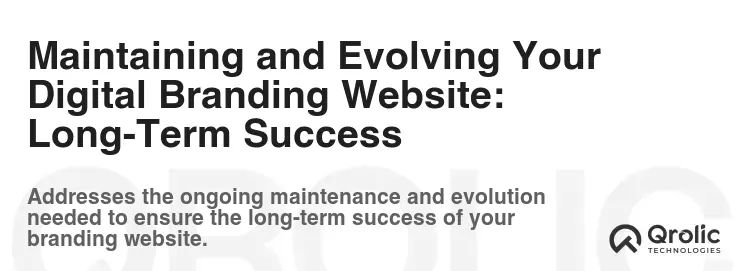
Regular Content Updates: Keeping Your Website Fresh
Keep your website fresh and engaging by regularly updating your content. This will not only attract more visitors but also improve your search engine rankings.
- Publish New Blog Posts: Share your expertise, provide valuable information, and drive organic traffic.
- Update Existing Content: Refresh your old blog posts and articles to keep them accurate and up-to-date.
- Add New Products/Services: Showcase your latest offerings.
- Share News and Announcements: Keep your audience informed about your company’s activities.
- Update Images and Videos: Replace outdated visuals with fresh content.
Security and Maintenance: Protecting Your Investment
Protect your website from hackers and malware by implementing security best practices and performing regular maintenance.
- Use a Strong Password: Choose a strong and unique password for your CMS and hosting account.
- Keep Your Software Up-to-Date: Regularly update your CMS, plugins, and themes to patch security vulnerabilities.
- Install a Security Plugin: Use a security plugin to protect your website from common threats.
- Back Up Your Website Regularly: Back up your website files and database to prevent data loss in case of a security breach or technical issue.
- Monitor Your Website for Malware: Regularly scan your website for malware and remove any infected files.
- Use HTTPS: Secure your website with an SSL certificate to encrypt data transmitted between your website and visitors.
Adapting to Changing Trends: Staying Ahead of the Curve
The digital landscape is constantly evolving, so it’s important to stay ahead of the curve and adapt your website to changing trends.
- Monitor Industry Trends: Keep up with the latest trends in website design, SEO, and digital marketing.
- Analyze Your Website Data: Use website analytics to identify areas where your website can be improved.
- Experiment with New Technologies: Try out new technologies and features to enhance your website’s functionality and user experience.
- Get Feedback from Your Users: Ask your website visitors for feedback on their experience and use it to make improvements.
- Stay Agile: Be willing to make changes to your website based on data and feedback.
Qrolic Technologies: Your Partner in Digital Branding Success

Qrolic Technologies (https://qrolic.com/) is a full-service digital marketing agency specializing in crafting compelling digital branding websites that drive results. We understand the intricacies of building a strong online presence and offer tailored solutions to meet your specific needs.
How Qrolic Technologies Can Help:
- Website Design & Development: We create visually stunning and user-friendly websites that reflect your brand identity and engage your target audience. Our team leverages the latest technologies and design principles to ensure your website is optimized for performance, SEO, and conversions. We specialize in platforms like WordPress, Shopify, and custom solutions to deliver the perfect fit for your business.
- Digital Branding Strategy: We help you define your brand voice, messaging, and visual identity to create a consistent and compelling brand experience across all online channels. Our strategic approach ensures that your website effectively communicates your value proposition and builds trust with your target audience.
- SEO Optimization: Our SEO experts optimize your website to rank higher in search engine results, driving organic traffic and increasing brand visibility. We conduct thorough keyword research, optimize your on-page content, build high-quality backlinks, and provide ongoing monitoring and reporting to ensure your website is performing at its best.
- Content Marketing: We create high-quality, informative, and engaging content that attracts visitors, builds trust, and drives conversions. Our content marketing services include blog writing, article creation, video production, and social media management.
- Conversion Rate Optimization (CRO): We analyze your website data, identify areas for improvement, and implement CRO strategies to increase the percentage of visitors who complete desired actions. Our CRO services include A/B testing, heatmap analysis, user surveys, and landing page optimization.
- E-commerce Solutions: If you are looking to sell products online, we develop robust and scalable e-commerce solutions that provide a seamless shopping experience for your customers. We offer a range of services, including product catalog management, payment gateway integration, shipping configuration, and marketing automation.
Why Choose Qrolic Technologies?
- Expertise: Our team has years of experience in digital branding, website design, SEO, and content marketing.
- Customized Solutions: We tailor our services to meet your specific needs and goals.
- Results-Driven Approach: We focus on delivering measurable results that help you achieve your business objectives.
- Transparent Communication: We keep you informed every step of the way and provide regular reports on your progress.
- Dedicated Support: We provide ongoing support and maintenance to ensure your website is always running smoothly.
Partner with Qrolic Technologies to create a digital branding website that elevates your brand, attracts more customers, and drives sustainable growth. Contact us today for a free consultation.
Conclusion: Your Journey to a Powerful Digital Brand
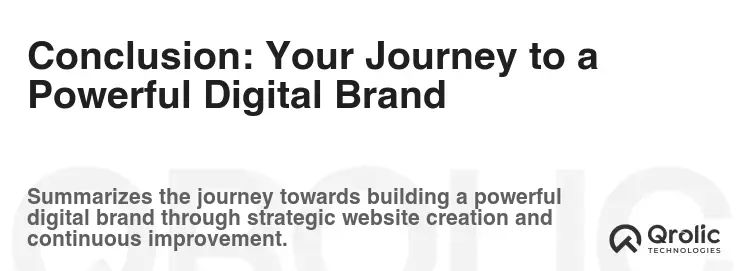
Creating a digital branding website is an investment in your future. By following this comprehensive guide, you can build a powerful online presence that establishes your brand identity, connects with your target audience, and drives business growth. Remember to prioritize user experience, create compelling content, optimize for search engines, and continuously adapt to changing trends. And when you need expert assistance, Qrolic Technologies is here to help you every step of the way. Your journey to a powerful digital brand starts now!






